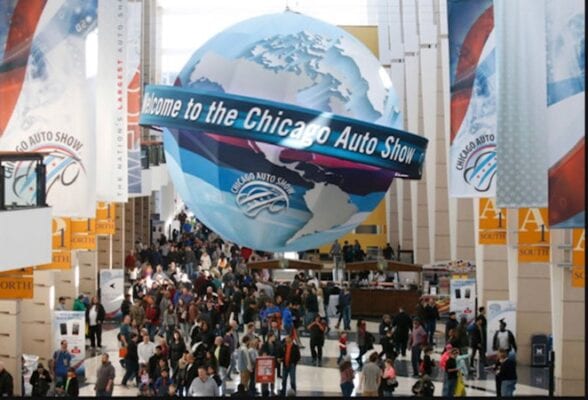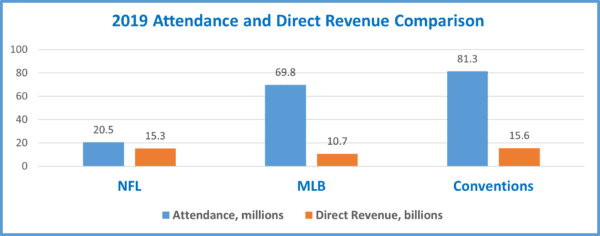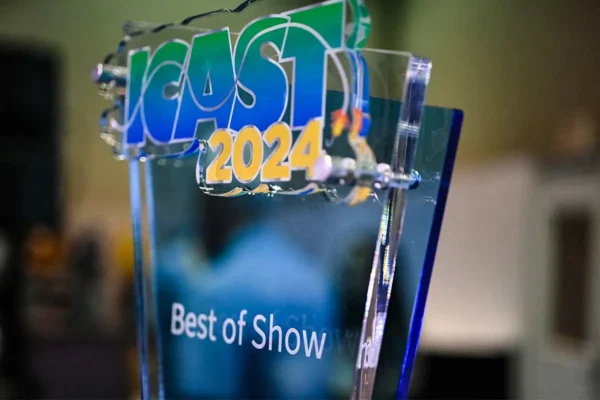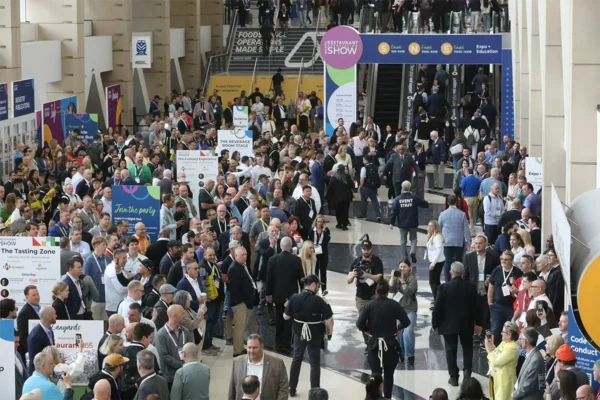by Bob McGlincy

 In 2019, the business meetings industry attracted more than 81 million individuals in the U.S., and employed more than 6,650,000 people (which is a larger number than what the auto industry employs). The industry is larger than Major League Baseball and the National football League in terms of revenue and attendance.
In 2019, the business meetings industry attracted more than 81 million individuals in the U.S., and employed more than 6,650,000 people (which is a larger number than what the auto industry employs). The industry is larger than Major League Baseball and the National football League in terms of revenue and attendance.
The chart below compares the attendance and direct revenue of the NFL, MLB and the convention industry. Attendance numbers are in the millions of people; revenue is in the billions of dollars. Baseball draws more total fans than football; but football generates more direct revenue, and draws a much higher percentage of the television audience. Conventions outdraw both sports in terms of attendees and direct revenue.

The convention industry’s contribution to the U.S. GDP is more than four times that of the NFL’s contribution ($446B to $91B). Conventions draw a higher percentage of out-of-towners than does baseball or football, at least during the regular season. And out-of-towners, at any event, tend to spend more money (if for no other reason than they need food, lodging and transportation). In terms of direct jobs, conventions at 6.6 million jobs in 2019 far exceeds the NFL’s 110,000 jobs.
The table below lists seven large events, and compares attendance, duration, and economic impact. The first three events are truly hybrid affairs, combining both live and virtual action. The 2019 World Series TV audience averaged almost 14 million a game, with a total of 97.2 million viewers for the seven game series. The Super Bowl viewership at 98.2 million was slightly larger, for one game. The Masters had 40,000 live fans on the final day, with a TV viewership of 11 million. The economic impact of face-to-face events is staggering.

*Paid attendance at the game was 70,081. Total number of people at SB events in Atlanta was estimated to be 500,000+, with 150,000 from out of town.
More people work in the convention industry than in the auto industry. There were 6.6 million jobs in 2019 in conventions versus 4.1 million jobs in all three phases of the auto industry (878,000 jobs in manufacturing, 1,973,000 in retail, and 1,249,000 in dealerships in March of 2021). There are several reasons why people consider the auto industry to be larger than conventions: first; it’s more visible (cars on the road, auto dealerships, repair shops, auto parts stores); second many people know of the Big 3 auto industry, when the vast majority of conventions businesses are a collection of small businesses … even the few large companies are mostly unknown outside of the industry; and third, the auto industry’s contribution to the GDP is in fact larger ($627 billion vs $446 billion for conventions in 2016).
The term “conventions” used here, includes both B2B and B2C meetings in a contracted venue—what I would describe as “travel-to business meetings.” It includes tradeshows, conventions, conferences and congresses (with or without exhibits); it does not include social, educational or recreational activities. Some analysts do not count B2C events as tradeshows; they exclude auto shows, for example, but sometimes include RV and trucking shows. It is my opinion that any business that displays product and secures leads should be counted as a tradeshow or business meeting.
The photos at the top of the article picture two of the largest shows of 2019, CES and Chicago Auto. CES showcased nearly 3 million square feet of exhibits; the Chicago Auto Show displayed a thousand vehicles, and has drawn more than a million people in the past. Despite the large crowds shown in the photos, tradeshows in 2020 and 2021 have proven to be safe and controlled experiences, with protective protocols in place.
Conventions are big business. They create jobs and generate sales. They impact the economy on both a micro and macro level, and they do so to a much larger extent than most people realize.
![]() Bob McGlincy is director, business management at Willwork Global Event Services. Willwork creates engaging, energized, and exceptional event experiences. He can be contacted at Bob.McGlincy@willwork.com
Bob McGlincy is director, business management at Willwork Global Event Services. Willwork creates engaging, energized, and exceptional event experiences. He can be contacted at Bob.McGlincy@willwork.com
Sources for data: NFL; MLB; Forbes; Statista; CEIR; Oxford Economics; US Bureau of Labor, plus various news articles for specific events.






























